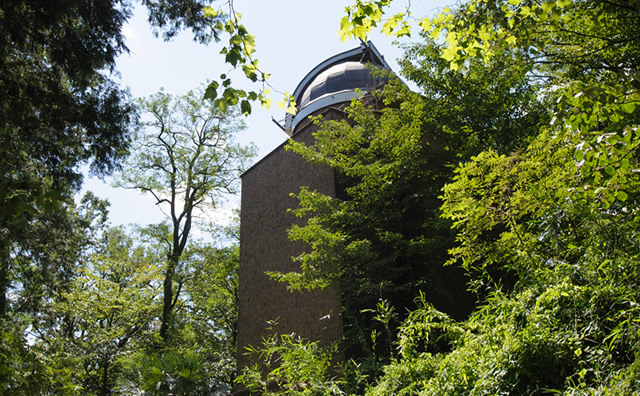Solar Tower Telescope
The Einstein Tower in Mitaka

Visitors can only view the building exterior.
The Solar Tower Telescope was designed by the Building and Repair Department of Tokyo Imperial University and was constructed by the Nakamura Komusho Company in 1930. The building is made of reinforced concrete, with five above-ground floors and one semi-basement. (The semi-basement alone was completed in 1926.) Sunlight streaming through the rooftop dome, standing 20 m (66 feet) above ground, is reflected by a 60-cm (24-inch) coelostat (consisting of two flat mirrors) and directed vertically down to the semi-basement. Then, the light is reflected again, this time into the large darkroom to the north and split into a spectrum. This building is called a “tower telescope” because the entire tower functions as a telescope tube.
The exterior design mostly consists of linear rectangular elements, but the curves found in the entrance, the eaves, and the rooftop balcony show the aesthetic sense of the designer. The outer walls of the building are embellished with brown scratch tiles arranged in an ingenious way taking advantage of the shade variations produced by uneven firing.
This building is nicknamed “the Einstein Tower” because it was built for the same purpose as the Einstein Tower of the Leibniz Institute for Astrophysics Potsdam, Germany.
This building was listed as a Registered Tangible Cultural Property of Japan in July 1998.
About
| Aperture | 60 cm (24 in) |
|---|
| Aperture | 48 cm (19 in) |
|---|---|
| Focal Length | 22 m (72 ft) |
| Purpose | Solar spectroscopy |
| Size | Height: 20 m (66 ft), Diameter: 5 m (16 ft) |
|---|---|
| Status | Registered Tangible Cultural Property |
| 1926 (Taisho Year 15) | Semi-basement completed |
|---|---|
| 1930 (Showa Year 5) | Tower completed |
| 1957 (Showa Year 32) | Upgraded to the current optical system |
| 1968 (Showa Year 43) | Retired from operation |
| July, 1998 (Heisei Year 10) | Listed as a Registered Tangible Cultural Property |
| 2000 (Heisei Year 12) | Opened to the public (only the exterior) |
| 2010 (Heisei Year 22) | Guided tours inside the building began |